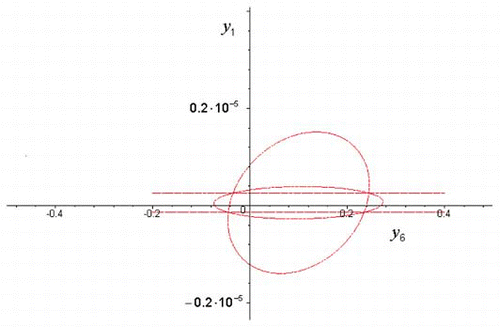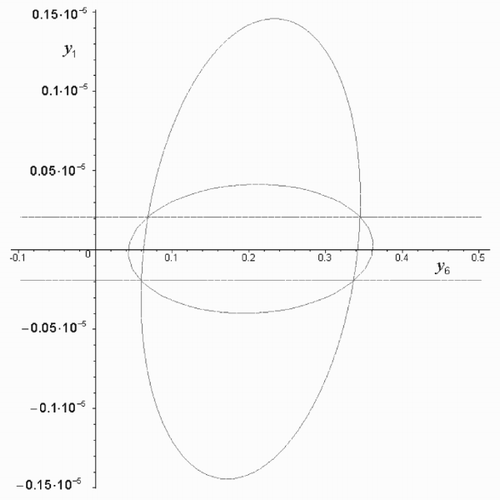Abstract
The equations of motion of a small satellite moving along a prescribed trajectory under disturbances are analysed. Problems of this kind have been extensively investigated. The corresponding equations for relative motion errors, caused by the uncertainties in initial conditions and control implementation imperfections, are linearized. The linear equations are reformulated and the evolution equations for optimal ellipsoidal estimates of these errors are derived. It is shown that ellipsoidal bounding of reachable sets is an efficient approach to model uncertain linear dynamical systems. The procedure constructed in this paper allows one to take into account discrete observations and to design control aimed at compensating the disturbances between measurements. These measurements are assumed to be performed with small errors. A numerical example is given which illustrates that the presented control design algorithm is quite efficient and allows one to keep the error between the real and desired motion close to zero.
1. Introduction
Multiple spacecraft formation flying is emerging as an enabling technology for a number of missions of NASA and other space agencies. Various aspects of this problem are addressed, e.g. in [Citation1 – Citation Citation Citation4]. In this paper a guaranteed ellipsoidal estimation approach is applied to the problem of follower (slave) satellite motion with respect to another leader (master) satellite. It is assumed that the trajectories of both the leader and follower are close to quasi-circular elliptic orbits. The problem of designing a control algorithm, as presented below, is examined for the follower satellite only.
Consider the motion of both leader and follower satellites along the same circular orbit at an altitude of 630 km above the Earth's surface with a speed of 7500 m/s. Let us compare two follower satellite control strategies: applying a small control (of fixed absolute value) transversally or tangentially with respect to the trajectory. and show that the small transversal change of velocity leads to a more significant orbit modification, while the tangential one just causes oscillations in the vicinity of the original motion. Hence we will focus on ‘transversal’ control.
Figure 1. Motion for the case of a tangential change of velocity (a) with respect to the Earth for the 1 m/s change in the same direction as the initial satellite motion, (b) the same change in velocity, with motion with respect to the master satellite, (c) relative motion for 1 m/s change in velocity in the direction opposite to the master satellite motion.
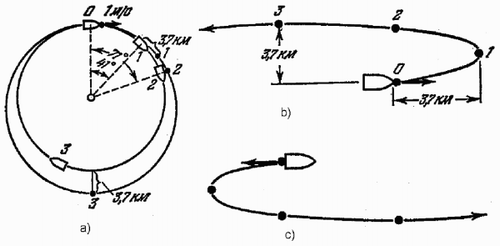
Figure 2. Motion for the case of a transversal change of velocity (a) with respect to the Earth for the 1 m/s change in the upward direction, (b) the same change in velocity, with motion with respect to the master satellite, (c) relative motion for the 1 m/s change in the downward direction.
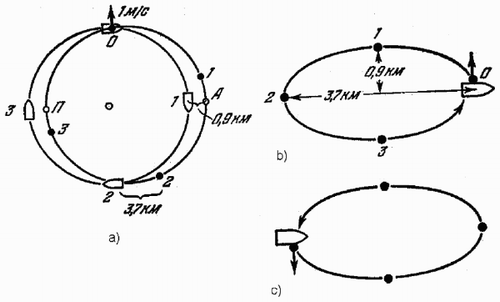
and , as well as the results given in [Citation5] and [Citation6], suggest that the transversal maneuver is more fuel efficient. Hence in section 4 we consider the control to be transversal. It will be seen later that the tangential control could also be easily incorporated in the framework of the results presented below.
2. Initial equations
In this section the motion of the follower satellite is examined (below the term ‘follower’ is omitted). The motion of a satellite, subject to the Earth's gravitational field and to control forces, is considered in an inertial Cartesian coordinate system with its origin at the Earth's centre. The units for the variables have been chosen in such a way that the mass of the follower satellite takes a unit value. Then its trajectory is obtained as a solution of the following system of differential equations:
In the absence of control
With assumptions Equation(3), Equationequations (1) and Equation(2) can be integrated. Define the initial conditions for Equation(2) in the form
where υ i are specific orbital parameters. The solution of Equation(1) with initial conditions Equation(4) can be presented in the form
Relations Equation(5) allow the use of υ1, … υ6 as new (osculating) coordinates introduced by these formulas for the case in which Equation(3) does not hold. Plugging in the coordinates Equation(5) into the Equationequations (1) we obtain
Note that Equation(5) implies that the functions Fi are solutions of Equation(1) with zero ui , so (∂Fi /∂t) = Xi , thus,
In the next section the osculating variables, which are convenient for further use, will be introduced and the equations in these coordinates will be derived.
3. Equations in osculating variables
The solution of Equation(1) with assumptions Equation(3) comprises an elliptic orbit. Introduce the osculating variables
Figure 3. Variables
for
Equation
(6)
.
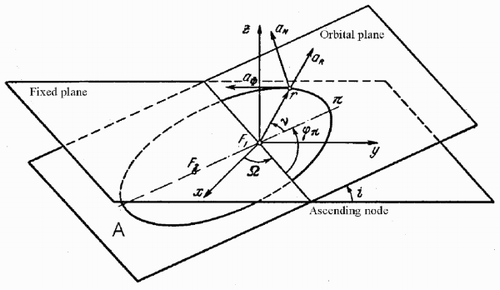
Then the Equationequations (6) take the form:
The functions introduced in Equation(7) are given below
The functions in Equation(8) define the right-hand sides for the system of equations in Equation(7) in terms of
4. Additional assumptions
The following assumptions are used to simplify equations Equation(11).
(1) The motion is considered in the vicinity of the quasi-circular orbit (with eccentricity
(2) Acceleration has a constant absolute value (during a given time interval) and is collinear with the velocity.
This means that in Equation(7) aR ≡aN ≡0, a Φ = u≡const. This control is designed to correct the orbit and make the motion closer to the prescribed one at some further time instant (e.g. at the right end of the given time interval). Then equations Equation(11) transform into the following system:
Introduce the latitude s of the satellite as a new independent variable. Denote by z the vector z = z(s) = {p,L,K,Ω,i,t}. Then the initial conditions in Equation(12) can be rewritten as z(s 0) = z 0 = {p 0,L 0,K 0,Ω0,i 0,t 0}. Define the error vector
Now consider the linearized equations. We assume that both acceleration u and eccentricity ϵ are small (
To estimate the set of possible satellite deviations from a given elliptic orbit, the outer ellipsoidal estimations of reachable sets [Citation1, Citation2, Citation6 – Citation Citation Citation9] are constructed.
5. Linearization and ellipsoidal estimates
On each interval of movement the small imperfections in control actuation and uncertainty in initial conditions must be taken into account. These control disturbances are presented by the vector w as defined below. For the variable y the linearization of equations Equation(13) (based on relations Equation(7) – Equation Equation Equation Equation Equation(12)) results in the following formulas:
Here δu is the error in the absolute value of u, δα is the angle between the projection of the (perturbed) acceleration vector onto the plane containing the prescribed orbit and perpendicular to the radius vector, and δβ is the angle between the (perturbed) acceleration vector and the plane containing the prescribed orbit. Denote by E(a,Q) an n-dimensional ellipsoid
Introduce for s = sk , k = 1,…, n, the values
Measurement of the first component is considered for the sake of simplicity; measurements of various components could be processed analogously. For each interval [sk ,sk + 1], k = 0, …, n we construct the outer ellipsoidal estimate E(a(s),Q(s)) containing all the solutions of Equation(14) with constraint Equation(16). We also take into account observation results Equation(17) and arrive at the following recurrent procedure. For the evolution of parameters a, Q (with the volume of the ellipsoid taken as the optimality criterion) on the interval [sk ,sk + 1], k = 0, …, n the following equations hold (see, e.g. [Citation7 – Citation Citation Citation Citation11]):
Here
Secondly, we define the values of
We choose a small constant control u = uk ,
Solutions of equations Equation(21) and Equation(23) with initial conditions Equation(22) and Equation(24) provide the values of the matrix functions
Thus, minimizing the length of the vector a(sk +1) yields
Formula Equation(26) implies the necessary condition
Finally, the values uk = ± U should be tested together with all roots of Equation(27) inside the interval |uk | ⩽ U. Then u k minimizing the value
6. Example
Consider the system Equation(12) with L 0 = 0.001, p(0) = 1, K 0 = Ω0 = i 0 = s 0 = 0. We construct the equations Equation(18) and Equation(19) for ellipsoidal estimates of y. In the relations Equation(16) we assume that
The projections of the ellipsoids onto the plane {y 1,y 6} are presented. The initial value of y was assumed to be
7. Conclusions
The presented ellipsoidal state estimation procedure provides control design under given bounds on uncertainties in the presence of noisy discrete observations. The example shows that this control design algorithm is quite efficient and allows one to keep the error between the real and the desired motion close to zero.
Acknowledgements
This work was partially supported by the Russian Foundation of Basic Research (Grant 02-01-00201) and by the Grant of the President of the RF for leading scientific schools No. 1627.2003.1 and by the Royal Society, UK.
References
References
- McInnes , CR . 1995 . Autonomous ring formation for a planar constellation of satellites . Journal of Guidance, Control, and Dynamics , 18 : 1215 – 1217 .
- Wang , PKC and Hadaegh , FY . 1996 . Coordination and control of multiple microspacecraft moving in formation . Journal of Astronautical Sciences , 44 : 315 – 355 .
- Ukybyshev , Y . 1998 . Long-term formation keeping of satellite constellation using linear-quadratic controller . Journal of Guidance, Control, and Dynamics , 21 : 109 – 115 .
- Beard , RW , McLain , TW and Hadaegh , FY . 2000 . Fuel optimization for constrained rotation of spacecraft formations . AIAA Journal of Guidance, Control, and Dynamics , 23 : 339 – 346 .
- Okhotsimsky , DE . 1964 . Investigation of motion in the central field for a satellite subjected to a constant transversal acceleration . Space Research , 2 ( No. 6 )
- Grodzovsky GL Ivanov JN Tokarev VV 1975 Mechanics of the Space Flight Moscow Nauka (in Russian)
- Chernousko FL 1994 State Estimation for Dynamic Systems Boca Raton CRC Press
- Milanese M Norton J Piet-Lahanier H Walter E (Eds) 1996 Bounding Approaches to System Identification New York Plenum Press
- Kurzhanski AB Valyi I 1997 Ellipsoidal Calculus for Estimation and Control Boston Birkhäuser
- Chernousko FL 1999 What is ellipsoidal modelling and how to use it for control and state estimation? In: I. Elishakoff (Ed.) Whys and Hows in Uncertainty Modelling Vienna Springer pp. 127 – 188
- Chernousko FL 2002 On optimal ellipsoidal estimation for dynamical systems subjected to uncertain perturbations Cybernetics and Systems Analysis No. 2 pp. 85 – 95
